Getting there
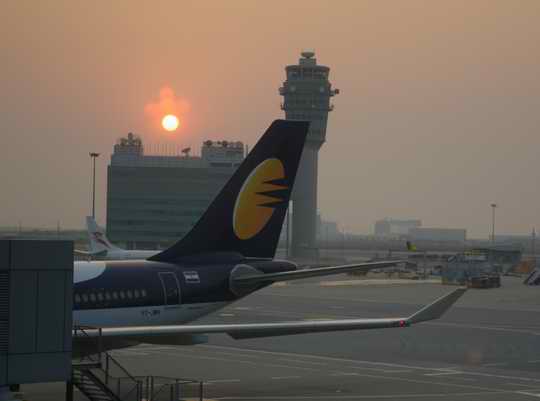
After a scare due to a delayed Manchester flight I just made the flight
from Heathrow to Auckland, joining nine of party on the same flight -
although I didn't spot any of them until arriving in Auckland! All but
one of us made it through the immigration, luggage collection and
customs/apple and boot checking obstacle race to the internal flight to
Christchurch. Due to the friendly coach-driver in Christchurch giving
us
a conducted tour of the city centre the person who missed the flight
actually arrived at the hotel a minute before the main party! By dinner
time all 15 of us had arrived and joined together in a yawning session
before rushing off to catch up on sleep....
Sunset at Hong Kong Airport
Saturday Jan 17
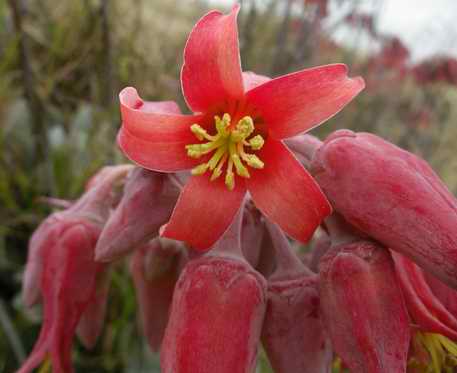 We were taken by Kevin,
the genial chatty bus driver, into the city centre to shop for a picnic
before heading to the coast at Sumner for the walk out to Godley Head.
Although never rising over 140m in altitude the walk managed to
accumulate over 600m of ascent and descent due to the ups and downs of
the coast path. Despite a number of dark clouds it never actually
rained - but then neither did the sun manage to penetrate the cloud.
Out of the wind it was warm though.
We were taken by Kevin,
the genial chatty bus driver, into the city centre to shop for a picnic
before heading to the coast at Sumner for the walk out to Godley Head.
Although never rising over 140m in altitude the walk managed to
accumulate over 600m of ascent and descent due to the ups and downs of
the coast path. Despite a number of dark clouds it never actually
rained - but then neither did the sun manage to penetrate the cloud.
Out of the wind it was warm though.
Pig's Ear Flowers (Cotyledon orbiculata)
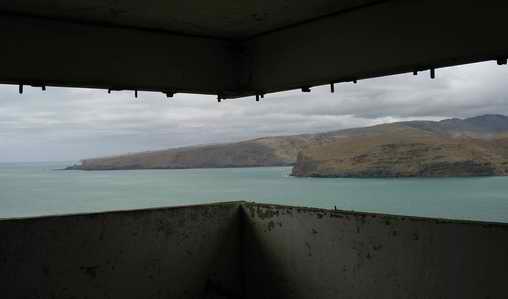
The fresh green hills of the Banks
Peninsula turned out to be brown, and the sheep we saw were equally
brown, and blended in well. The hills were dotted with the pink flowers
of the Pig's Ear - one of the many South African flowers flourishing
along the coast path. Lunch was taken on
the newly installed picnic tables overlooking Lyttleton Harbour, and
some of the party set off to explore the concrete remains of a WWII
battery - gun emplacements and lookout shelters scattered over the
hillside. Back at Sumner there was time to consume ices and drinks
before heading back by coach to the hotel.
View over Lyttleton Harbour Inlet from a WWII Bunker
Sunday Jan 18
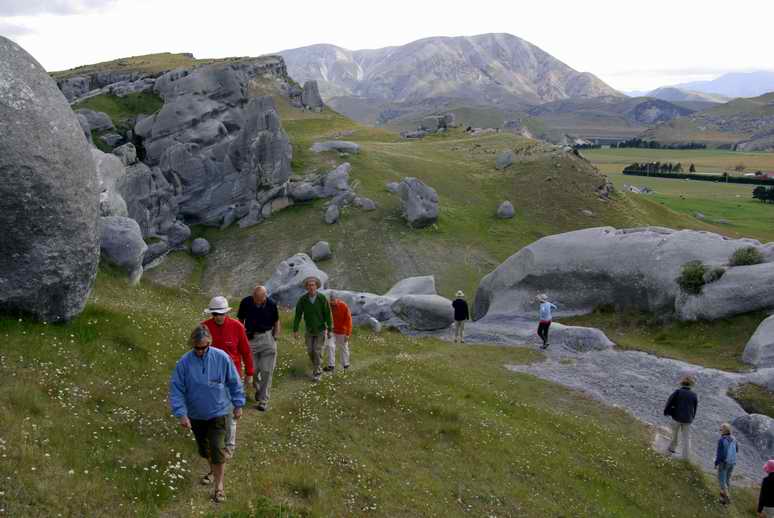 We set off at 8 am by coach driven this time by Des
Jolly with his quiet commentary. First stop was at Castle Hill Rocks,
which warranted a full page of dos and don'ts in the Department of
Conservation's Handbook for Ramblers' Leaders. The rocks are soft
limestone and have weathered to irregular rounded shapes more commonly
associated with sandstone. The contrast with the sharply eroded
mountains which surround the outcrop is marked. Mountain daisies
flowered everywhere between the rocks. We didn't know it at the time,
but that was the end of dry weather for the day, for as we approached
Arthur's Pass the rain began and the clouds descended over the
surrounding peaks. This made the stop at Hokitika a short one - just a
dive into a cafe for lunch & then off! The walk up to Sentinel Rock
to view the Franz Josef Glacier was even shorter, as it came on to rain
somewhat heavier. Not enough energy had been used up during the day, so
a small party set off after dinner to check whether glow-worms still
glow in the damp. The winding Minihaha trail snakes through fern filled
forest and is renowned for glow worms and, yes, they did glow in the
damp - a series of spectacular little displays of pin-prick lights on
tree-trunks and rock faces.
We set off at 8 am by coach driven this time by Des
Jolly with his quiet commentary. First stop was at Castle Hill Rocks,
which warranted a full page of dos and don'ts in the Department of
Conservation's Handbook for Ramblers' Leaders. The rocks are soft
limestone and have weathered to irregular rounded shapes more commonly
associated with sandstone. The contrast with the sharply eroded
mountains which surround the outcrop is marked. Mountain daisies
flowered everywhere between the rocks. We didn't know it at the time,
but that was the end of dry weather for the day, for as we approached
Arthur's Pass the rain began and the clouds descended over the
surrounding peaks. This made the stop at Hokitika a short one - just a
dive into a cafe for lunch & then off! The walk up to Sentinel Rock
to view the Franz Josef Glacier was even shorter, as it came on to rain
somewhat heavier. Not enough energy had been used up during the day, so
a small party set off after dinner to check whether glow-worms still
glow in the damp. The winding Minihaha trail snakes through fern filled
forest and is renowned for glow worms and, yes, they did glow in the
damp - a series of spectacular little displays of pin-prick lights on
tree-trunks and rock faces.
The group walking at Castle Hill Rocks
Monday Jan 19
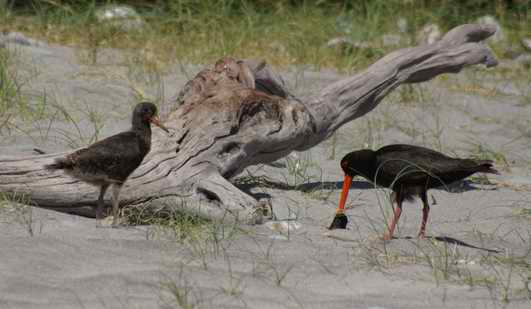 A day of three
halves (or how to pack alot into one day...):
A day of three
halves (or how to pack alot into one day...):
First half: a walk around Lake
Matheson to see the renowned reflection of Mount Cook in its still
waters....we saw the reflections of the low clouds over the mountains
in the ripples on the lake. Still, the walk in the ferny forest
was enchanting;
Second half: a walk through the
former gold mining area of Gillespies Beach, where we saw the rusting
remains of a dredge sunk in a pool surrounded by tree ferns and gorse
bushes, and a tunnel built by the miners to give access to the next
beach. The walk, downwind along the driftwood strewn beach was fine,
but it needed determination to get back into the wind. En route
we were entertained by the antics of a family of oystercatchers ;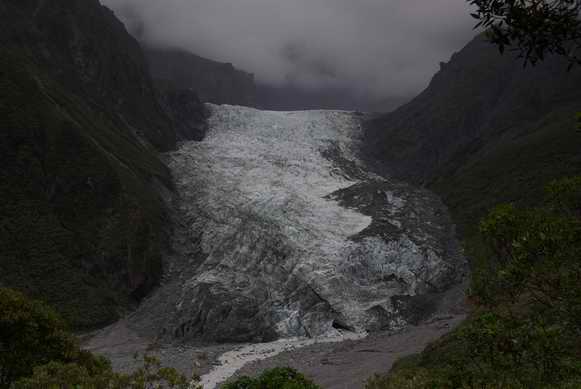
An oystercatcher parent intent on
not feeding baby
Third half: after a break for
lunch we walked up a trail to the chalet lookout point above the snout
of the Fox Glacier. Despite the persistent low cloud the lower end of
the glacier was still an awe-inspiring sight - more so as we knew two
tourists had been killed by collapsing ice the previous week - by
venturing beyond the safety barriers at the foot of the glacier
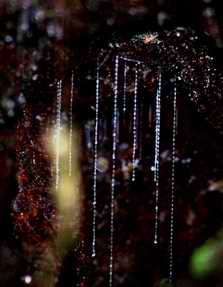
Fox Glacier (well the lower 10% of it!)
Oh, and a fourth half too - we went down the road after dark to the
Minnehaha track through the forest to look for glow-worms - actually
fly (gnat-like)
larvae that use the light to attract flies onto their dangling, sticky,
fishing lines. We found them! They favour slightly overhanging rock or
fallen tree
stumps, and make a constellation-like display of pin-prick lights in
the dark, quite enchanting!
Glow-worm 'fishing lines'
Tuesday Jan 20
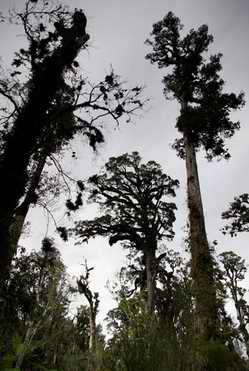 Time to leave Fox Glacier
and drive down the west coast as far as Haast, then cross over the
Southern Alps by the lowest pass at only 563m altitude, and down to
Wanaka. This took all day, as we stopped every hour or so to visit
something, or walk. We started with a salmon farm - really to buy some
picnic lunch, but an excuse to drink more coffee and watch salmon of
all sizes swimming round in circles. Then it was a quick stop at
Knights Point to look at some distant stationary black blobs, allegedly
fur seals. It was also our first chance to get bitten by sandflies.
Time to leave Fox Glacier
and drive down the west coast as far as Haast, then cross over the
Southern Alps by the lowest pass at only 563m altitude, and down to
Wanaka. This took all day, as we stopped every hour or so to visit
something, or walk. We started with a salmon farm - really to buy some
picnic lunch, but an excuse to drink more coffee and watch salmon of
all sizes swimming round in circles. Then it was a quick stop at
Knights Point to look at some distant stationary black blobs, allegedly
fur seals. It was also our first chance to get bitten by sandflies.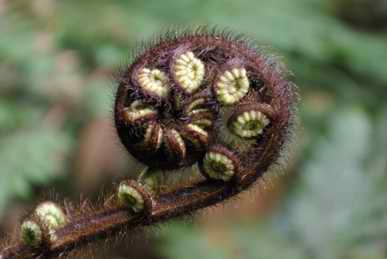
The second chance came with a stop at Ship's Creek, up which we walked
to view the swamp loving Kahikatea Trees, incredibly tall and straggly
looking, and the many of tree ferns. After lunch, and well away from
sand flies we stopped to view Thunder Falls, which crash into the Haast
River onto beautiful grey rocks with convoluted folded white bands.
Finally (well almost finally, if you ignore a further coffee stop and
one photo stop over Lake Hawea) we stopped at the top of the pass and
walked for an hour down to Davis Flats along the old packhorse track.
This was through beech forest, and the covering of the tiny fallen
beech leaves made the path both soft underfoot and quiet. The ferns
this time were all on the forest floor, making the forest seem quite
open despite the density of trees - a magic experience.
Tree Fern 'Fiddle-end'


 We were taken by Kevin,
the genial chatty bus driver, into the city centre to shop for a picnic
before heading to the coast at Sumner for the walk out to Godley Head.
Although never rising over 140m in altitude the walk managed to
accumulate over 600m of ascent and descent due to the ups and downs of
the coast path. Despite a number of dark clouds it never actually
rained - but then neither did the sun manage to penetrate the cloud.
Out of the wind it was warm though.
We were taken by Kevin,
the genial chatty bus driver, into the city centre to shop for a picnic
before heading to the coast at Sumner for the walk out to Godley Head.
Although never rising over 140m in altitude the walk managed to
accumulate over 600m of ascent and descent due to the ups and downs of
the coast path. Despite a number of dark clouds it never actually
rained - but then neither did the sun manage to penetrate the cloud.
Out of the wind it was warm though. 
 We set off at 8 am by coach driven this time by Des
Jolly with his quiet commentary. First stop was at Castle Hill Rocks,
which warranted a full page of dos and don'ts in the Department of
Conservation's Handbook for Ramblers' Leaders. The rocks are soft
limestone and have weathered to irregular rounded shapes more commonly
associated with sandstone. The contrast with the sharply eroded
mountains which surround the outcrop is marked. Mountain daisies
flowered everywhere between the rocks. We didn't know it at the time,
but that was the end of dry weather for the day, for as we approached
Arthur's Pass the rain began and the clouds descended over the
surrounding peaks. This made the stop at Hokitika a short one - just a
dive into a cafe for lunch & then off! The walk up to Sentinel Rock
to view the Franz Josef Glacier was even shorter, as it came on to rain
somewhat heavier. Not enough energy had been used up during the day, so
a small party set off after dinner to check whether glow-worms still
glow in the damp. The winding Minihaha trail snakes through fern filled
forest and is renowned for glow worms and, yes, they did glow in the
damp - a series of spectacular little displays of pin-prick lights on
tree-trunks and rock faces.
We set off at 8 am by coach driven this time by Des
Jolly with his quiet commentary. First stop was at Castle Hill Rocks,
which warranted a full page of dos and don'ts in the Department of
Conservation's Handbook for Ramblers' Leaders. The rocks are soft
limestone and have weathered to irregular rounded shapes more commonly
associated with sandstone. The contrast with the sharply eroded
mountains which surround the outcrop is marked. Mountain daisies
flowered everywhere between the rocks. We didn't know it at the time,
but that was the end of dry weather for the day, for as we approached
Arthur's Pass the rain began and the clouds descended over the
surrounding peaks. This made the stop at Hokitika a short one - just a
dive into a cafe for lunch & then off! The walk up to Sentinel Rock
to view the Franz Josef Glacier was even shorter, as it came on to rain
somewhat heavier. Not enough energy had been used up during the day, so
a small party set off after dinner to check whether glow-worms still
glow in the damp. The winding Minihaha trail snakes through fern filled
forest and is renowned for glow worms and, yes, they did glow in the
damp - a series of spectacular little displays of pin-prick lights on
tree-trunks and rock faces. A day of three
halves (or how to pack alot into one day...):
A day of three
halves (or how to pack alot into one day...): 

 Time to leave Fox Glacier
and drive down the west coast as far as Haast, then cross over the
Southern Alps by the lowest pass at only 563m altitude, and down to
Wanaka. This took all day, as we stopped every hour or so to visit
something, or walk. We started with a salmon farm - really to buy some
picnic lunch, but an excuse to drink more coffee and watch salmon of
all sizes swimming round in circles. Then it was a quick stop at
Knights Point to look at some distant stationary black blobs, allegedly
fur seals. It was also our first chance to get bitten by sandflies.
Time to leave Fox Glacier
and drive down the west coast as far as Haast, then cross over the
Southern Alps by the lowest pass at only 563m altitude, and down to
Wanaka. This took all day, as we stopped every hour or so to visit
something, or walk. We started with a salmon farm - really to buy some
picnic lunch, but an excuse to drink more coffee and watch salmon of
all sizes swimming round in circles. Then it was a quick stop at
Knights Point to look at some distant stationary black blobs, allegedly
fur seals. It was also our first chance to get bitten by sandflies.